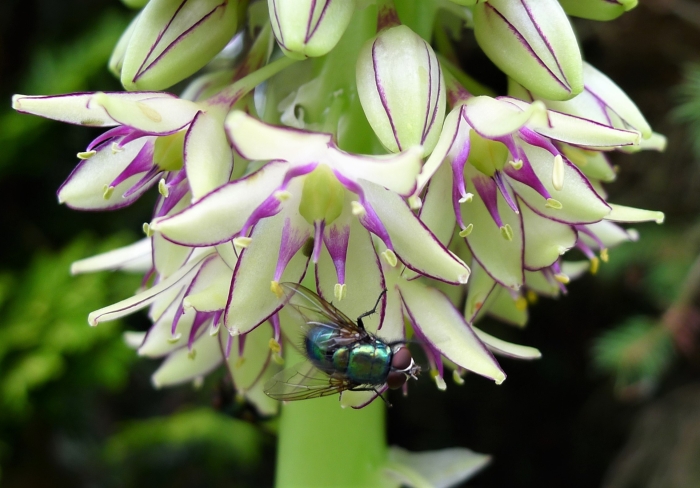Pineapple Lily
(Eucomis bicolor)
Pineapple Lily (Eucomis bicolor)
/
/

gailhampshire from Cradley, Malvern, U.K
CC BY 2.0
Image By:
gailhampshire from Cradley, Malvern, U.K
Recorded By:
Copyright:
CC BY 2.0
Copyright Notice:
Photo by: gailhampshire from Cradley, Malvern, U.K | License Type: CC BY 2.0 | License URL: https://creativecommons.org/licenses/by/2.0 | Uploader: Rudolphous | Publisher: Wikimedia Commons | Title: Fly_on_Pineapple_Lily_(Eucomis_bicolor)_(35202071924).jpg | Notes: {{Information |Description={{en|1=Eugenia carissoides (syn.Eugenia reinwardtiana), 'Cedar Bay Cherry', fruit and branch.}} |Source=Own work by uploader |Author=[[User:Zaareo|Zaareo]] |Date=July 2009 |Permission
















Estimated Native Range
Summary
Eucomis bicolor, commonly known as Pineapple Lily, is a deciduous perennial bulb native to South Africa, specifically grasslands and rocky slopes. It features a rosette of strappy leaves and grows to a height and width of 1-2 feet. The plant is named for its flower spike, which resembles a pineapple, with a tuft of green bracts atop a dense raceme of star-shaped flowers with contrasting colors of cream, green, purple, and white, blooming in the summer. The flowers are quite showy and can add an exotic touch to gardens.
Pineapple Lily is valued for its unique flower spikes and ease of care. It is often used in borders, container gardens, and as a focal point in ornamental beds. It thrives in full sun to partial shade and prefers well-drained soil. While it requires regular watering during the growing season, it is drought-tolerant once established. After flowering, reduce watering as the plant goes dormant. In colder climates, the bulbs should be lifted and stored over winter. Potential problems include bulb rot if overwatered and slug or snail damage to the leaves. Eucomis bicolor is not known to be invasive and does not typically present problems with aggressive roots.CC BY-SA 4.0
Pineapple Lily is valued for its unique flower spikes and ease of care. It is often used in borders, container gardens, and as a focal point in ornamental beds. It thrives in full sun to partial shade and prefers well-drained soil. While it requires regular watering during the growing season, it is drought-tolerant once established. After flowering, reduce watering as the plant goes dormant. In colder climates, the bulbs should be lifted and stored over winter. Potential problems include bulb rot if overwatered and slug or snail damage to the leaves. Eucomis bicolor is not known to be invasive and does not typically present problems with aggressive roots.CC BY-SA 4.0
Plant Description
- Plant Type: Bulb
- Height: 1-2 feet
- Width: 1-2 feet
- Growth Rate: Moderate
- Flower Color: Green, Purple
- Flowering Season: Summer
- Leaf Retention: Deciduous
Growth Requirements
- Sun: Full Sun
- Water: Medium
- Drainage: Medium, Fast
Common Uses
Bee Garden, Border Plant, Butterfly Garden, Deer Resistant, Low Maintenance, Potted Plant, Salt Tolerant, Showy Flowers
Natural Habitat
Native to South African grasslands and rocky slopes
Other Names
Common Names: Variegated Pineapple Lily
Scientific Names: , Eucomis bicolor,
GBIF Accepted Name: Eucomis bicolor Baker